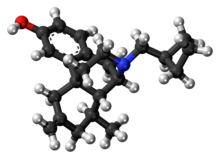Xorphanol
Source: Wikipedia, the free encyclopedia.
Opioid analgesic
 | |
 | |
| Clinical data | |
|---|---|
| ATC code |
|
| Identifiers | |
| |
JSmol) | |
| |
| |
| | |
Xorphanol (
INN) (developmental code name TR-5379 or TR-5379M), also known as xorphanol mesylate (USAN), is an opioid analgesic of the morphinan family that was never marketed.[1][2][3]
Xorphanol is a mixed
opioid-dependent individuals).[3][10] The drug has also been found to act as an agonist of the δ-opioid receptor (Ki = 1.0 nM; IC50 = 8 nM; Imax = 76%).[11]
Xorphanol produces potent analgesia, and was originally claimed to possess a minimal potential for
euphoria, and this was the subject of a lawsuit between the drug's inventors and the company to which they had licensed the marketing rights, which claimed that these side effects had not been revealed to them during the license negotiations.[16]
As a result of this dispute, the drug was never marketed commercially.
See also
- 6-Methylenedihydrodesoxymorphine
- Butorphanol
- Cyclorphan
- Ketorfanol
- Levallorphan
- Levomethorphan
- Levorphanol
- Nalmefene
- Nalbuphine
- Nalorphine
- Oxilorphan
- Proxorphan
References
- ISBN 978-0-7514-0499-9.
- ISBN 978-0-08-058369-3.
- ^ ISBN 978-0-471-85548-4.
- ISBN 978-0-89766-441-7.
- S2CID 31977725.
- PMID 3018570.
- PMID 16433932.
- ISBN 978-1-4832-8798-0.
- PMID 12513698.
- ISBN 978-81-85790-03-9.
- PMID 12437765.
- PMID 6796691.
- S2CID 31842402.
- PMID 4039650.
- PMID 6642105.
- ^ Maruho Company Ltd v Miles Inc (1993) 13 F.3d 6
(NMDAR
antagonists)
| Arylcyclo‐ hexylamines |
| ||||||
|---|---|---|---|---|---|---|---|
| Adamantanes | |||||||
| Diarylethylamines | |||||||
| Morphinans |
| ||||||
| Others |
(mAChR
antagonists)
- Atropine
- Benactyzine
- Benzatropine
- Benzydamine
- Biperiden
- BRN-1484501
- Brompheniramine
- BZ
- CAR-226,086
- CAR-301,060
- CAR-302,196
- CAR-302,282
- CAR-302,368
- CAR-302,537
- CAR-302,668
- Chloropyramine
- Chlorphenamine
- Clemastine
- CS-27349
- Cyclizine
- Cyproheptadine
- Dicycloverine
- Dimenhydrinate
- Diphenhydramine
- Ditran
- Doxylamine
- EA-3167
- EA-3443
- EA-3580
- EA-3834
- Flavoxate
- Hyoscyamine
- JB-318
- JB-336
- Meclozine
- Mepyramine
- Orphenadrine
- Oxybutynin
- Pheniramine
- Phenyltoloxamine
- Procyclidine
- Promethazine
- Scopolamine
- Tolterodine
- Trihexyphenidyl
- Tripelennamine
- Triprolidine
- WIN-2299
Natural | |||||||||||
|---|---|---|---|---|---|---|---|---|---|---|---|
| Synthetic |
|
enhancers
(Mixed MOA)
- Aliphatic hydrocarbons
- Aromatic hydrocarbons
- Ethers
- Haloalkanes
- 2-EMSB
- Alazocine
- Bremazocine
- Butorphan
- Butorphanol
- Cyclazocine
- Cyclorphan
- Cyprenorphine
- Diprenorphine
- Enadoline
- Herkinorin
- Heroin
- HZ-2
- Ibogaine
- Ketazocine
- Levallorphan
- Levomethorphan
- Levorphanol
- LPK-26
- Metazocine
- Morphine
- Nalbuphine
- Nalmefene
- Nalorphine
- Noribogaine
- Oxilorphan
- Pentazocine
- Phenazocine
- Proxorphan
- Racemethorphan
- Racemorphan
- Salvinorin A
- Spiradoline
- Tifluadom
- U-50488
- U-69,593
- Xorphanol
| μ-opioid (MOR) |
| ||||
|---|---|---|---|---|---|
| δ-opioid (DOR) |
| ||||
| κ-opioid (KOR) |
| ||||
| Nociceptin (NOP) |
| ||||
| Others |
| ||||
